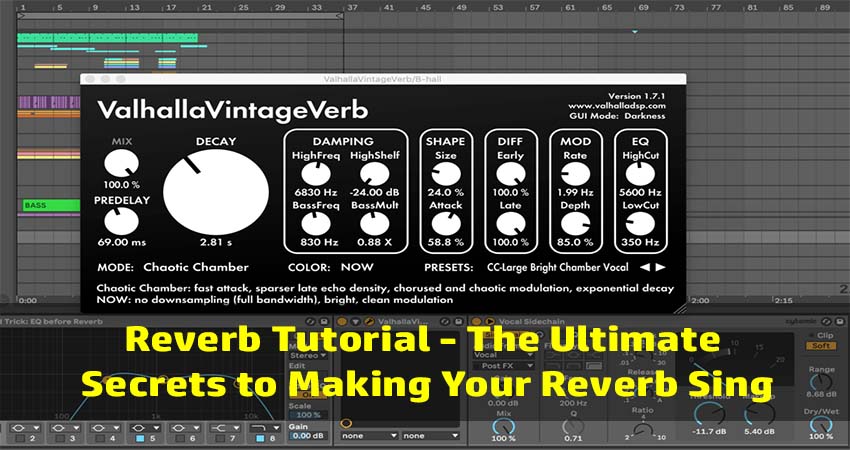
Welcome to our reverb instructional exercise! Reverb is one of the most valuable and possibly fascinating devices with regards to the specialist's tool compartment. Maybe no other impact is so elaborately flexible, and positively none is as incredible in its capacity to cause an audience's ears "to envision" a circumstance outwardly.
Most contemporary creations utilize different assortments of cautiously tuned reverb. There are many chronicle or execution situations where the utilization of reverb has, for quite some time, been the standard as opposed to the particular case. (Toward the finish of our reverb instructional exercise, we'll get into only a couple of these situations.)
Reverb instructional exercise stage 1:
Stuff you'll have To attempt your outcomes as we come, you'll need some gadget fit for delivering reverb live on the fly, and the capacity to drive a sign through this gadget (an amplifier and your voice, for example). Interface your test signal through the contribution of the reverb and run the yield of the reverb to your earphones or observing the speaker. On the off chance that you don't as of now have a gadget or module to make your reverb, you can get old multi-impacts units inexpensively from your preferred neighborhood classifieds website or online closeouts. Be that as it may, a PC running a reverb module through a host programming is likely a more straightforward and less expensive decision for most clients. Most account programming bundles accompany in any event one reverb module, which should work fine. (Note: Setting up your belongings unit or host programming is past the extent of this reverb instructional exercise. See your client's manual.)
Reverb instructional exercise stage 2:
Change the wet/dry sign levels Your wet/dry controls modify the proportion of unaffected information signal ("dry") to the resonated signal being created ("wet"). Undoubtedly, your reverb gadget will introduce these parameters in one of two different ways: An) as two separate parameters, with independent changes for wet level versus dry level, or B) as a single handle that moves the sign from progressively soaked to increasingly dry as you turn. Raise a reverb preset; at that point, take a stab at altering the evaporate signal level and down as you acquire your test signal. Tune in to what befalls the yield. You will probably discover this the best outcomes with your test design at around 40-60% wet. Leave this setting set up and go to stage 3 of our reverb instructional exercise. (Note: For some real applications, you will need your reverb set to 100% wet; any dry sign returning from the reverb may struggle with dry sign effectively present in the blend and result in horrendous sounding stage crossing out of the dry. Remember this for sometime later.)
Reverb instructional exercise stage 3:
Attempt distinctive reverb calculations Most reverb gadgets will let you select between various sorts of reverb on the fly. You may see words like "corridor," "plate," "spring," or "room," and your reverb unit may even have more than one of each kind ("Plate 2," and so forth.). Every one of these sorts is known as a reverb calculation. Every calculation is intended to emulate another kind of exact surrounding space or truly applicable reverb-unit plan. With your wet sign went up to 50-70%, evaluate a few distinctive reverb types, and aurally assess the contrasts between them. You will see that plates and springs commonly will, in general, be more splendid and progressively fake-sounding, which isn't a terrible thing by any stretch of the imagination. Pick one calculation and proceed onward to the subsequent stage.
Reverb instructional exercise stage 4:
Alter reverb parameters Your reverb calculation presumably has various further modifications. However, the most significant by a long shot are the alterations for new reflection level (which may likewise be marked "pre-reflection") and rot time. Recall that reverb's fundamental reason for existing is to mimic a room or other such condition that would change any stable sources found inside such a space. These controls are by a long shot the most significant in controlling the components of the "virtual space" and your audience's place inside it. In a reverb calculation, early reflections (when present) impersonate the impact of the sign bobbing off the closest dividers to the audience. The rot time controls the thoughts from what might be "wherever else" in real space: the side and back dividers of the room. If you need a private room sound, you will need a shorter rot time and progressively noticeable early reflections. For the impact of a massive show lobby, the ideal settings are the opposite: longer rot time and calmer initial thoughts. Play around with these settings as you get your test signal. We've arrived at the finish of our reverb instructional exercise, however, while you despite everything have your test arrangement running, it's a smart thought to play with the other accessible settings, for example, recurrence damping/sifting, which can likewise be valuable to control the sound of your reverb and to assist it with mixing better in the blend. Here is some fantastically regular cutting edge utilizes for a reverb that you can set up rapidly using only the data from this reverb instructional exercise: Lead vocals (Hall or plate calculation, 1-5s rot) Acoustic guitar/acoustic piano (Hall or room calculation, 0.5-3s rot) Clean electric guitar (Spring calculation, 0.5-1.5s rot) Snare drum (Hall or room calculation, 0.5-2s rot) Other cool uses incorporate gated reverbs, invert reverbs, and various smart impacts which sadly are outside the extent of our reverb instructional exercise.
Most importantly, recall that reverb ought to be utilized elegantly. It is a typical fledgling mix-up to use to an extreme degree an excess of reverb. The rehearsed architect will utilize sufficiently only to improve the sign, however not really as to occupy from the music.
See More: What does a reverb effect do?